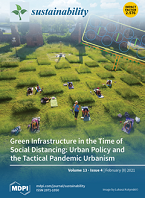-

“Not as safe as I believed”: Differences in perceived and self-reported cycling behavior between riders and non-riders
Sergio Useche, Javier Gené-Morales, Félix Siebert, Francisco Alonso, Luis Montoro
(2021). ArticleSustainability. No.13(4), 1614
Cycling behavior remains a key issue for explaining several traffic causalities occurring every day. However, recent studies have shown how the assessment of the own safety-related behaviors on the road may substantially differ from how third parties assess them. Thus, the aim of this study was to evaluate the differences between cyclists’ self-reported behavior and the proxyreported behavior that other (non-cyclist) road users perceive from bike riders. For this purpose, this study used data from two samples: (i) 1064 cyclists (M = 32.83 years) answering the Cycling Behavior Questionnaire—CBQ, and (ii) 1070 non-cyclists (M = 30.83 years) answering an adapted version of the CBQ for external...
Cycling behavior remains a key issue for explaining several traffic causalities occurring every day. However, recent studies have shown how the assessment of the own safety-related behaviors on the road may substantially differ from how third parties assess them. Thus, the aim of this study was to evaluate the differences between cyclists’ self-reported behavior and the proxyreported behavior that other (non-cyclist) road users perceive from bike riders. For this purpose, this study used data from two samples: (i) 1064 cyclists (M = 32.83 years) answering the Cycling Behavior Questionnaire—CBQ, and (ii) 1070 non-cyclists (M = 30.83 years) answering an adapted version of the CBQ for external raters—ECBQ. The results show how the self-reported and proxy-reported behaviors of cyclists greatly differ in terms of all behavioral factors composing the CBQ model, i.e., traffic violations, riding errors, and positive behaviors. Also, external raters (non-cyclists) are those targeting significantly riskier behaviors than those self-reported by cyclists. These discrepancies between perceived behaviors may give rise to conflicting viewpoints on the interaction between bicycle riders and other road users. Therefore, this study underscores the importance of behavioral awareness, providing highlights for future studies on the behavioral interaction between cyclists and other road users. Results can be used to improve the road safety of all road users by giving indications on self-and proxy-perceived safety-related behaviors and visibility of protective riding habits.
Read more Hide13(4), 1614
DOI: 10.3390/su13041614 -

Guía Metodológica para Entornos Escolares Seguros en República Dominicana
Reviewers: Francisco Alonso, Jorge Suárez, José Luís Velarte
(2020). LlibreThe guide aims to adapt the school environment to the needs of children and adolescents, in order to reduce the risk in their travel to and from schools. According to national data consolidated by the Permanent Observatory of Road Safety (OPSEVI), for the year 2019, of the total number of traffic fatalities, approximately 14% were children and adolescents under 20 years of age, i.e., mainly of school age. The Guide for the Evaluation and Implementation of Safe School Environments is a technical document that contains the necessary and relevant information to carry out an effective plan that obtains short-term results from the moment the information is collected to its subsequent analysis in...
The guide aims to adapt the school environment to the needs of children and adolescents, in order to reduce the risk in their travel to and from schools. According to national data consolidated by the Permanent Observatory of Road Safety (OPSEVI), for the year 2019, of the total number of traffic fatalities, approximately 14% were children and adolescents under 20 years of age, i.e., mainly of school age. The Guide for the Evaluation and Implementation of Safe School Environments is a technical document that contains the necessary and relevant information to carry out an effective plan that obtains short-term results from the moment the information is collected to its subsequent analysis in areas surrounding the school premises, as well as the routes used by students, their behavior in relation to vehicular and pedestrian mobility and their safety for the transfer of students.
Read more Hide ISBN: 978-9945-9238-9-6






